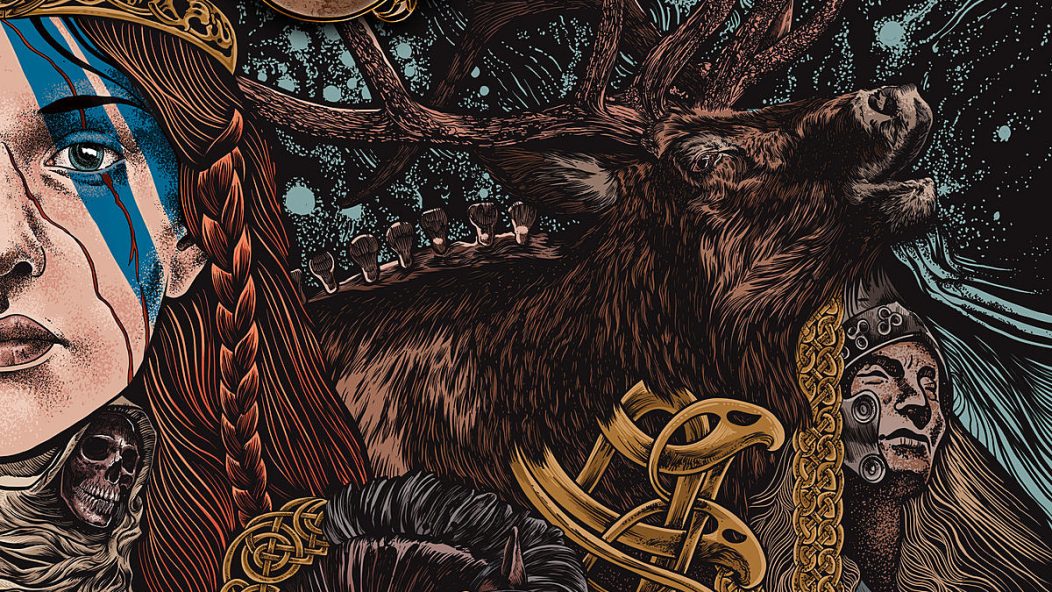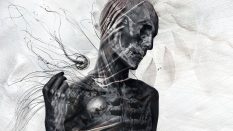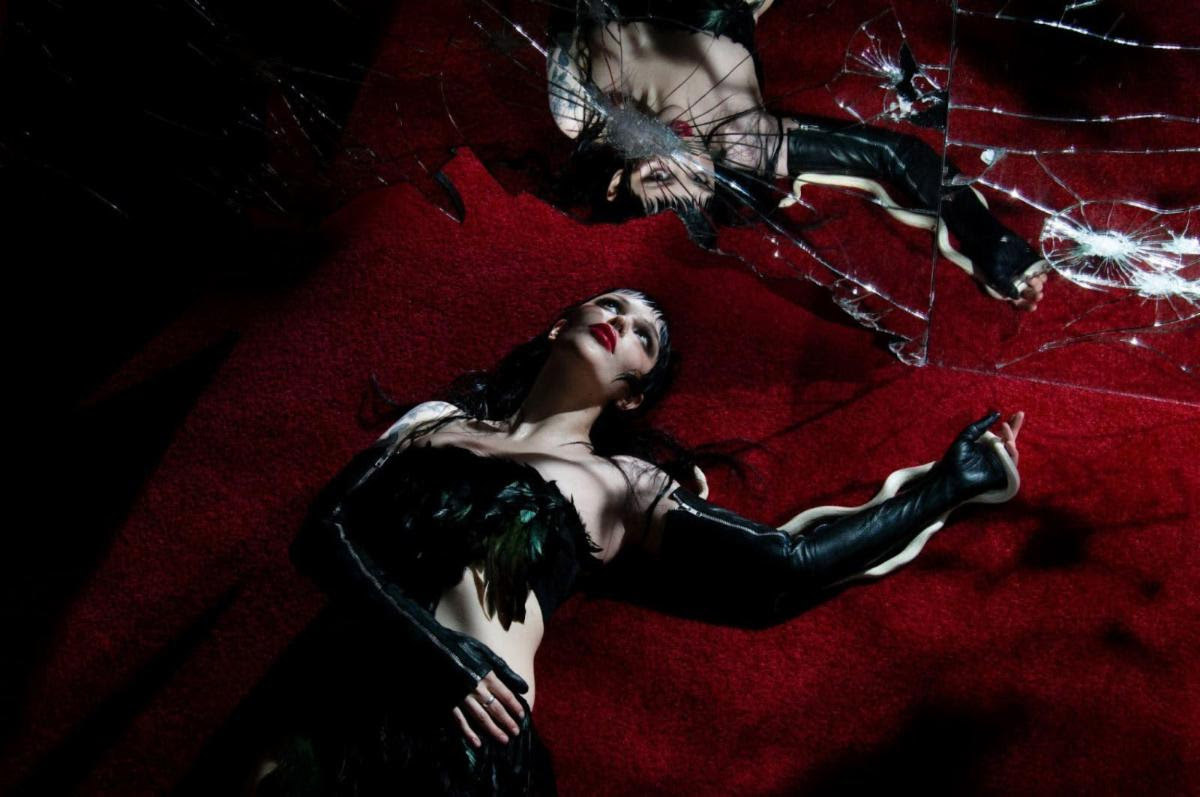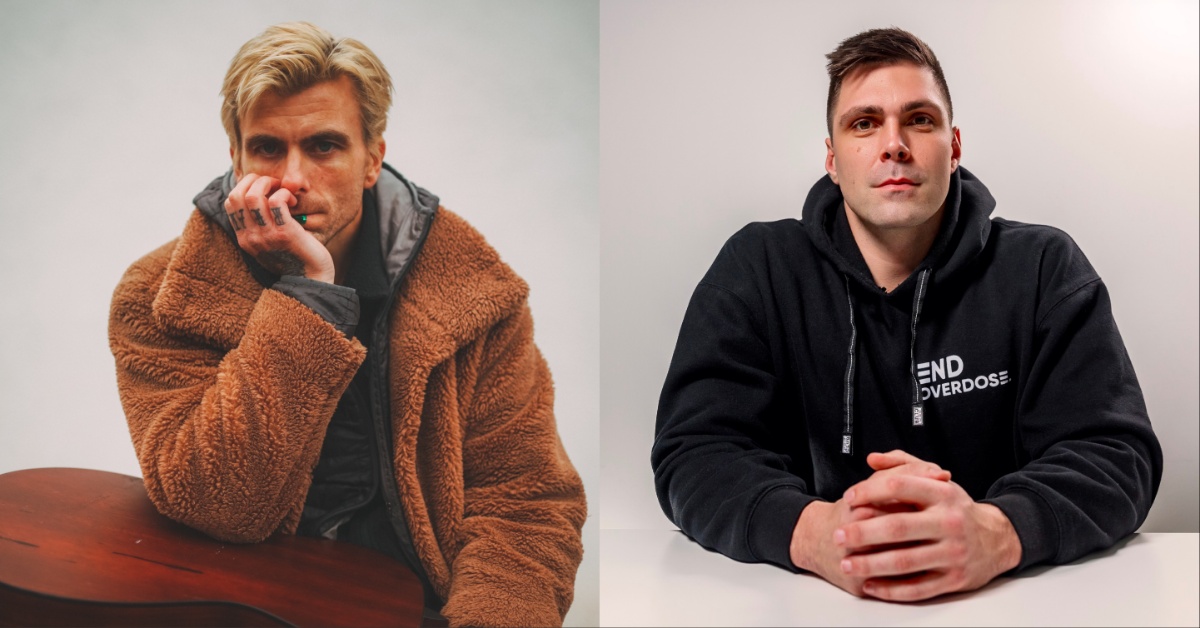
Folk Metal Legends Cruachan Exist Between "The Living And The Dead" (Interview)
Ireland’s folk metal progenitors Cruachan have been creating their unique brand of music since its 1992 formation. By combining traditional Irish folk music with elements of black, death, and thrash metal, Cruachan single handedly invented the folk metal genre.
Led by founder/vocalist/multi-instrumentalist Keith Fay, Cruachan have been a globally influential band for over 30 years. Laying the blueprint for current modern folk metal bands such as Ensiferum, Korpiklaani, Finntroll, Eluveitie, and more, Cruachan have firmly established a legacy within the scene.
On their ninth full-length album The Living And The Dead, which released last month, Cruachan continues their craftsmanship of catchy anthems with a Celtic flavor and a nod toward Irish mythology and history. Fay recently spoke with us during a Zoom chat about the origins of the band, creating the folk metal genre, the new album, and possible future touring and festival plans.
…
…
Formed in 1992, Cruachan are considered to be the first real folk metal band. Were you aware of any other artists who were creating the type of music you were when first forming?
I knew of Skyclad, even as a kid. I think I was 12 years old when I got into metal and playing music. And within a year, I started to broaden my horizons, even at that young age. I think Skyclad had a song on the cover of Metal Hammer, that’s how I first heard of them and I got their first album. I thought it was great, but to me it was just a thrash album. It was a long time before I realized Skyclad really had a significance in folk metal, because that album was pretty much 90% thrash. But there’s one real folk song on there, “The Widdershins Jig.” I remember thinking it was really good. I was very much into folk music at that early age, and I wanted to bring it into metal. But I was just excited by anything that was different. Another big influential band for me back then was Nocturnus, the Florida death metal band. They were billed as death metal with keyboards. It was like fucking revolutionary, I was blown away by that. But we just take that stuff in stride nowadays. But back then, it worked. I was so excited that somebody was trying something different.
Growing up, were you already into Celtic music and traditional Irish folklore?
Not really. Folk music became really popular around Europe I’d say almost 30 years ago. Throughout the ’90s, folk music became super trendy, because all around Europe there were these folk music revivals. It was gone out of popular culture there; it was gone out of just the everyday normality and it came back with a bang and people were like, “This is cool.” That never happened in Ireland, because folk music never died away. It never needed a revival because it’s just omnipresent. We grew up with it. We lived it. We’d hear ads on TV advertising cheese, and it’d be folk diddly-ized, jigs and reels, that kind of stuff. It was what my dad was listening to. And kids growing up in the ’80s were like, “That music sucks.” I hated it, but luckily that changed for me. But for a lot of people it didn’t, and that affected Cruachan. We weren’t that popular when we started in Ireland. But for me personally, it changed. That’s where the whole folk thing came from. But as a youngster, I definitely wasn’t interested in it at all. It didn’t have that coolness that the rest of Europe enjoyed.
You mentioned that you are coming from more of a black metal aesthetic on your debut album, did that set the precedent for the genre?
It really did. And honestly Kelley, when I tried to go back and get some memoirs while thinking about writing a book, I was trying to go back to what memories I have from that time. I’ve got some videos, some old VHS horror movie recordings on it. Not only am I young, but I behave like I’m really childish back then. Luckily, I was into music and I wrote what even back then I thought was decent, good, acceptable music. For all the seriousness it was meant to have, it appeals to young teenagers, who were the biggest fans of black metal back then, and I loved it. So I wanted to do some of that, but I wanted to do everything. I love heavy metal, and on that first album you’ll hear thrash metal, death metal, black metal, tons of folk music. And the reality is, nothing has changed. One of our criticisms is always that we don’t seem to have picked what form of metal we are. And that’s true. The only consistent thing you’ll find in Cruachan is the folk music, when it comes to metal, you’ll hear everything from a Judas Priest style riff right up to a Darkthrone style riff, because that’s what I do. But having said that, there’s a lot of people that love that too, and that’s why we’re still here today doing what we do.
Were you already familiar with your fellow countrymen Primordial and what they were doing?
Absolutely. Alan (Averill, aka A.A. Nemtheanga) says he released his demo sometime in the ’80s, which would place him at being eight or nine years of age. So I don’t know exactly how real that story is. But they were definitely formed before us. And in that kind of demo scene, when we were just making demos playing the few shows in Dublin, we were all really close. Alan’s a good friend of mine to this day, Ciaran, who’s the main guy in Primordial in the background, he’s a great musician. We’ve all remained friends and are as close as ever. We love when we end up on festivals and tours together; our music’s quite different. They’re still quite dark, we’re not as dark. But we get on really well. So it is fun when we do end up at a festival together. It’s like any Irish people, just stick pints of Guinness in front of us and we’re all best friends!
Current bands such as Ensiferum, Korpiklaani, Finntroll, Eluveitie, etc., have put their own stamp on the genre. But do you think that Cruachan is the blueprint for what they’re doing?
We are absolutely the reason those bands exist. We were never going to have the success that those types of bands have, because we all have day jobs. We were never going to commit fully to touring and the band becoming a priority. It’s far too risky; we’ve all got families, mortgages, and we’ve got decent career jobs. So we were just never prepared to do that. Some very good friends of mine are in Alestorm, and they live off their music, but they didn’t always live off their music. They had a few years where they had a lot of risks that they took personally to get to where they are. When we get out on the road or when we play festivals, it’s fine. But having said that, we had to turn down supporting Arkona on the United States tour very recently, we had to turn down Alestorm who invited us to tour Europe with them. We just can’t do a month to two months of touring, it’s never going to be a possibility. We have the luxury to create music, because we absolutely love creating music. We make it perfect, we make it exactly what we want it to be. Those other bands have to create a product that’s going to pay for their dinner, that’s going to pay for their house, they have to make it work. And that’s probably a mean way to put it. But it is the reality. Whatever music these bands put out, it’s their income. With Cruachan, it’s not. Our music is purely created from the heart. And you can take that or leave it. I’m not saying the quality of anyone else’s music is less or more. If anything, you could potentially say it’s better, they have to make good albums because they’re depending on the sale to have their lifestyle accrued upon them.
What is the reason why you don’t tour very often?
It’s a few things. Mainly, it’s our (day) jobs. I’ve got a pretty white collar career. So, I’m depending on my allotment of vacation days to be with my family, go on vacation with my family and squeeze in some time with the band. In Ireland, that’s 25 days a year. So there’s not much we can manage with that. And then the rest of (the band), our violin player now, Audrey, she’s only two years in the band. She’s a teacher, and the other guys have jobs as well. When I was in my 20s, okay, fair enough. But now I’m in my mid 40s heading towards my 50s, I just don’t want to do that. But I do love playing live; I love being on stage. But before then, that was quite successful. Just before COVID-19, we were hitting all the big festivals. And we expect that now COVID-19 has gone. We have a new album; we expect to be hitting up those really big shows again.
Speaking of influences and your music. Cruachan implements a great balance between metal and the Celtic elements. How do you go about making your music accessible to people who may not share your ancestry or history or even fondness for Celtic music? What elements do you try to implement to sway the skeptical fans?
If you’re writing music and you’re trying to appeal to somebody, you’re probably missing the point. I write music that I think sounds fantastic, sounds great. I can envision a perfect song. I just try to write music that appeals to me, that I think is really good. But I’m under no illusions that the music I’m creating; it’s Irish folk music, it’s ballads. Just look at St. Patrick’s Day, we must be the only country in the world that has an Internationally, universally celebrated day. I can’t think of any other country that has a day where the whole world is, “Good Ireland, let’s drink our Guinness!” It’s insane. Some of that love obviously comes from our history and how we migrated around the world, but it’s just that kind of innocent party atmosphere. So just by osmosis, or just naturally, we’re going to attract people into our music and into what we do. And we have such moments of lightness and brevity and really accessible folk music that people probably hear playing and they’re like, “Oh my god, this is great.” And then the metal kicks in, and sometimes it’s really extreme metal, and they’re like, “This is terrible. Why would you ruin a song like this?” So, I think we attract as many people as we irritate… and that’s fine.
You perform almost all the instruments in the band, how did you become so prolific as a multi-instrumentalist? How do you marry these traditional Irish instruments such as the bodhrán, bouzouki, mandolin, bagpipes, and tin whistles with the rock/metal formula?
I think heavy metal has come from folk music. I found in Irish folk music, (that) there’s always a rhythm section behind the melody that’s playing, and the rhythm is usually chords, very simple chords on acoustic guitar. And then you have the melody playing on the flute, teamed with the violin, whatever it is. I found that it was very easy back in those 13 to 14 year-old days to just translate those chords into the kind of heavy metal riffs to power chords that we all love. The melody remained the same, I was hitting up the power chord instead of the natural acoustic guitar chords, and it was working. And then I was just moving into a death metal riff back into the folk rhythms that you’d expect to hear. I don’t know if it would be the same for everyone else, but for me, it just seemed to work; it flowed naturally. This is what I wanted to do. I wanted metal and I wanted folk music. But I always found it quite a natural form of music to create.
When did you take over lead vocals and how did that come about?
I was lead vocalist on that first album and the demos. Then we had a slight break up and then we got back together with the album The Middle Kingdom, which was a much different album. It was much lighter. There’s one little moment on it that’s a little bit black metally. And we brought in a friend called Karen (Gilligan) to sing two or three songs and I was going to sing the ballad vocal for the rest. And I remember asking Karen if she would sing pretty much every song on this album and I’ll do some of the background vocals here and there. That was it, Karen became a full time member. She was our lead vocalist for The Middle Kingdom, Pagan, Folk-Lore, and The Morrigan’s Call. After The Morrigan’s Call, she decided to call it a day, she was just not into metal music. She wasn’t into playing live or touring. Throughout this album my vocal ability improved, thankfully. And by The Morrigan’s Call there were a lot of death metal vocals coming back, I really wanted to go into the kind of heavier stuff after Folk-Lore into The Morrigan’s Call. Then when Karen left, I just thought I’m not going to replace her, I’m not going to bring in another female vocalist. I took over the lead vocals again and the rest is history. There’s a huge part of our catalog that has lead female vocalists, and even on the newer albums we have some lead female vocal parts. So you will usually see us with a female vocalist on stage, and for the past two years, Kim Dylla, the old vocalist for GWAR, has been pretty much our full-time female vocalist when we play live, when we can make it work. Sometimes just the distance between having that Atlantic Ocean in the way can be a bit of a pain, but when we can make it work.
The new songs off The Living And The Dead have some great storytelling. Lyrically, what are you trying to convey?
The previous album, Nine Years of Blood, was a concept album. I fully told a story from start to finish about that epic nine-year war between Ireland and England in the 1400s. And how close Ireland came to beating England and how the world would look if that was the case. Ultimately, we lost. But it’s such an exciting period of history that I wanted to put it into a concept album, which was a pain in the ass. I had this rigid, strict set of songs I needed to write about, and some events weren’t as exciting as others. So when it came to the new album, I could go back to writing what I wanted. There was a time in Ireland where a horrible embarrassment and national shame of the country was in the news more and more, called the mother and baby homes. The Catholic Church here throughout the last 100 or so years, would bring fallen women; women who liked to be alive, maybe they were pregnant outside of marriage. But they were put into these mother and baby homes, the Catholic Church around them here in Ireland, and throughout the world; they were in France, they were in Belgium. If children were born, they were sent away. They were adopted; a lot of Irish kids from this period ended up in the US. But more horrifically, a lot of them were killed. And there were stories coming to light. One of the big ones was at the Tuam mother and baby home, they found hundreds of dead baby skeletons in a septic tank. And the last mother and baby home was only shut down as recently as 1992 or ’93. It affected me, and that’s where the likes of “The Children,” “The Ghost,” “The Crow” (came from). I wrote those songs to commemorate and honor those poor women; the poor children that went through the horrific period. “The Crow” ties into our Irish mythology that we always have in our albums. The crow is the Morrigan, that Celtic war goddess, calling. These kids have fought their war against the Catholic Church, they lost and the Morrigan’s came to take them away. The album is kind of in two halves. It’s almost another concept album, but it’s not. There’s a few other songs mixed around there.
Although it’s not a full concept album, it is heavily themed. Listening through the whole album is like a cinematic soundtrack, almost like you’re watching a movie. How did you go about constructing it, dealing with the emotions and the storytelling and the music fitting together?
I love classical music, it’s probably the music I listen to mostly at the moment, and for a very long time. Over the last few albums, there were cellos, violins, and beautiful string sections were creeping in. But this album, I really achieved my goals. And that was partly because Audrey is just so skilled, she’s been playing since she was four years of age. If we look at the track “The Reaper,” I wrote those lyrics about my dad while he was alive. It was written out of frustration that he wasn’t taking care of himself. Little did I know he would eventually die. And I looked at the lyrics and thought I’d love to do something to commemorate my dad. It’s a snapshot of how I felt at that time. And that’s why that middle section has one of the biggest classical strings motifs, almost as you said, cinematic. It sounds like something Hans Zimmer would create for a movie. And I know self praise is no praise, I don’t mean it in that way, it’s just as a comparison. To me, it sounds like Hans Zimmer, and I achieved my goal. I really think I commemorated my dad really well in that song. And I did work in some of the titles; the last line of “The Ghost” is talking about a tree that a child hung himself from and he’s pretty much a ghost, and he just notices on the shortest branch of a tree he sees a crow. Then the next song is “The Crow,” and on the shortest branch it continues telling the story all the way through the album. And we went with The Living And The Dead as the title because we knew there’s such a disparity. There’s four or five songs that really connect. So, I thought the living and the dead really do tie this album together.
You are the only original member remaining from its formation, while the rest of the band joined in 2020. What is the current band camaraderie and musical chemistry like between all its members?
It’s the best it’s ever been. We did bring in a load of new members in 2020, but one of them was Joe, the previous drummer for nearly 15 years. He left and wanted to get back into music but he was done with drumming so he came back in on bass. He’s just an old friend. COVID-19 just gave some of the members that left that period of time to reflect on what they wanted to do. Kieran (Ball), the old guitarist was just done with music, he didn’t want to play live. John Ryan, our violin player, wanted to be more in the lead role in the band. He wanted to be more of the manager, more control and he was never going to have that opportunity with Cruachan because clearly that’s my part. So we brought in Audrey, we brought in Tom on drums. So we’re left with Tom, Audrey, myself and Joe. We’ll probably stick with that, we won’t get a second guitarist in. We’re just happy now, it’s a nice four piece unit. We can play every song we want. We’re very professional and we’re really happy where we are.
The band celebrated their 30th anniversary last year. What has led to the band’s longevity and perseverance?
Being the only main guy, let’s face it, there are a few bands out there, you look at Tom G Warrior of Celtic Frost and Tryptikon. (When you have one member) who can be the focus, it can be a good thing. Bands that have an equal part; five key members, but if one or two leave, then the band may break up. For 30 years, you could argue there should be like 15 or 20 albums. But there’s not, we’ve only done nine. That’s the more cynical way of looking at it.
Since you don’t do lengthy tours, have you committed to any festivals yet for this summer?
We’re looking at doing some Irish shows, we’re headlining The Seeds Of Limerick Festival next month. Almost every festival that we’re in touch with has some kind of hangover from COVID-19, they probably canceled so many years, they’ve had so many commitments they brought the lineups into this year, and so on. As bad as it sounds, 2023 is a tough one; there’s not much going on. But we’ve got a lot of tentative confirmations for 2024. We think we’ll be back to normal by then, but I can’t make any official announcements because nothing is really set in stone. We may do a one week or so tour of Europe as well later this year. And that’s half-driven by the record label, they need to have us out there, our fans want to see us. If we can’t get to a festival, they don’t care what stage we’re on, whether it’s a small stage in a local pub or a big stage at a festival. They literally don’t give a shit. So we need to do something to get out there for them.
…
The Living and the Dead was released on March 24th via Despotz Records.











